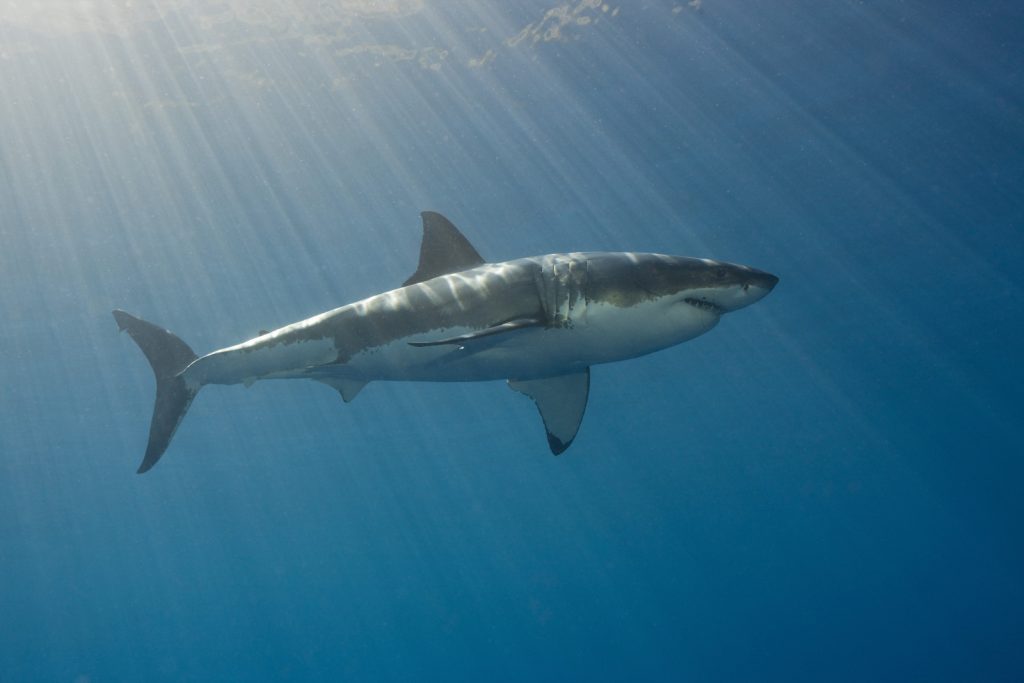Great white sharks are mostly kept at bay by shark exclusion nets such as this one at Fish Hoek. Photos: Prisma Bildagentur/Getty Images, Rodger Bosch/AFP & Leila Dougan
The two fatal shark attacks in Plettenberg Bay between June and last month doubled the local annual average on that part of the coastline, sparking debate about whether shark activity in South African waters is on the rise — and, if so, why.
In June, local resident Bruce Wolov was killed by a great white shark at Sanctuary Beach. Less than three months later, Capetonian Kimon Bisogno died after a great white shark bit her at the nearby Central Beach, the National Sea Rescue Institute and Bitou municipality said.
But experts say shark attacks remain extremely rare and the apparent increase in their activity on the south-east coast of South Africa can be attributed to multiple factors, some of them human-caused.
They also emphasise that the real threat is in the other direction, the one humans pose to sharks.
South Africa is a world hotspot for cartilaginous fish — sharks, rays, skates and chimaeras — and 42% of them are threatened with extinction.
Two species — the largetooth sawfish and green sawfish — are considered locally extinct and 11 species are critically endangered, said Lauren van Nijkerk, director of campaigns at the nonprofit WildTrust.
There are thought to be only about 550 great whites off the South African coast and these creatures, representing evolutionary development that began more than 100-million years ago, are classified as vulnerable.
A specialist at the Shark Museum in Simonstown, Alessandro de Maddalena, noted with concern the declining numbers of South African sharks “year after year”.
“I’ve seen it happening with my own eyes and I’m not talking only about great whites,” he said.

De Maddalena listed some of the larger shark species approaching extinction in South Africa as the blue shark, shortfin mako, ragged tooth and smooth hammerhead.
“Where we used to see from five to 10 great white sharks a day, now we struggle to see a single individual.”
According to shark safety and research organisation Shark Spotters, between 2005 and 2016, 50 to 300 great whites used to be seen from Cape Town’s beaches annually.
The sightings were primarily in False Bay, Muizenberg, Kalk Bay, Fish Hoek and Kogel Bay.
Since 2017, great white sightings by Shark Spotters have declined, reaching fewer than five last year.
Studies are investigating changes in the population size of white sharks in our waters, said Shark Spotters’ chief executive Sarah Waries.
She said there had been a significant shift in their distribution over the past five to seven years, with numbers declining in areas such as False Bay and Gansbaai and activity apparently increasing from Algoa Bay to Mossel Bay.
“There appears to have been an eastward shift in white shark distribution along the coastline … There could be numerous drivers of this, including the presence of orcas that prey on sharks,” she added.
In Plettenberg Bay, one of the factors in the growing presence of great whites was the expanding seal colony on nearby the Robberg peninsula. Seals are sharks’ main prey.
Alison Kock, a marine biologist and shark specialist at South African National Parks, said there was evidence to suggest predation by orcas on large coastal sharks started in 2015 in False Bay, with the prey at that stage being seven-gill sharks.
In 2017, when white shark sightings started declining in False Bay, killer whales also started to attack white and bronze whale sharks.
“Before this, only orcas occurring offshore were known to predate on offshore species, such as blue sharks.
“We don’t know why they shifted to large, coastal sharks in 2015,” Kock said, adding that more research was needed to better understand their behaviour.
The phenomenon of orcas preying on large, coastal sharks has also been recorded in the United States, Australia and South America.
Shark movement, and why they relocate to different areas, is an ongoing line of scientific inquiry, Kock said.
Citing local and international studies, she pointed out that the movement of white sharks can be influenced by the maturity status and sex of the animals, prey availability and predator avoidance. Further factors can include habitat type, seasonality and water temperature.
“Observing sharks is difficult, and most sharks are not tagged, and even if they are tagged, the data might not be in real-time. Most of their behaviour remains hidden from us.”
Hollywood, particularly Steven Spielberg’s Jaws, has given a grossly distorted picture of the menace posed by sharks to humans.
The Yearly Worldwide Shark Attack Summary shows only 73 unprovoked shark-bite incidents took place globally during the whole of last year — just nine of them fatal.
The chances of dying in an earthquake — 1 in 110 000 — are more than 10 times as great as being killed by a shark, where the chances are one in 1.9-million. In stark contrast, at least 100-million sharks are killed a year and the toll may be much higher — closer to 270-million.
 Kimon Bisogno was fatally bitten by a shark in Plettenberg Bay last month.
Kimon Bisogno was fatally bitten by a shark in Plettenberg Bay last month.
According to the International Union for Conservation of Nature, more than 37.5% of the 1 200 known species are threatened with extinction, with overfishing the primary threat to two-thirds of them.
In South African waters, Kock says the main threats to shark and ray populations are overfishing and habitat degradation.
“Other emerging threats are changes in ocean temperatures and ocean acidification, both due to climate change,” explained Kock, adding: “Large sharks face few natural hazards and the natural threats are significantly smaller than anthropogenic [human-made] ones.”
Kock underscored the critical environmental importance of sharks and rays, which “are essential for maintaining diverse and healthy marine ecosystems”.
“Many species also have high cultural and societal value and contribute to economies through fishing and tourism,” she emphasised.
The WildTrust’s Van Nijkerk believes South Africa can be a “lifeboat” for cartilaginous fish.
She hoped the WildTrust’s Sanctuary for Sharks and Rays campaign, in collaboration with the department of environment, forestry and fisheries, will turn the spotlight on the importance and value of new sanctuary areas.
The hope is for an additional 5% — the current figure is 5.4% — of protection for South Africa’s mainland waters, which would include critical habitats and areas for species that are slow to mature and produce few young.
“The creation of sanctuaries for sharks and rays in South Africa is critical for their increased protection and the health of our ocean and our people,” said Van Nijkerk.